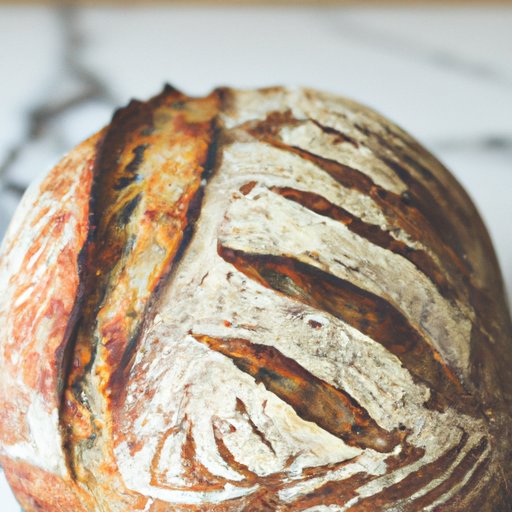Introduction
Sourdough bread has become increasingly popular, especially among individuals who seek healthier alternatives to commercial bread. Sourdough bread is distinct from other types of bread as it takes longer to make and requires a sourdough starter, which is a mixture of flour, water, and natural yeasts and bacteria. This article will introduce you to the equipment and ingredients required for making sourdough bread, provide a step-by-step guide, and share tips and techniques for success in bread-making.
Equipment and Ingredients
Making sourdough bread requires some essential equipment, including a mixing bowl, measuring cups and spoons, a kitchen scale, and a container for making the starter. The ingredients needed include flour, water, salt, and the starter culture. It’s essential to select the right flour for sourdough bread-making, such as unbleached wheat flour, rye flour, or spelt flour, as this will affect the bread’s flavor and texture.
Making the starter culture is a critical step. You can make a starter culture by mixing equal parts of flour and water, leaving it at room temperature, and feeding it daily for about a week. To maintain the starter culture, it’s vital to discard some of it and feed it with fresh flour and water at regular intervals.
Step-by-Step Guide
a. Making the starter culture
1. Combine equal parts of flour and water in a container, then stir until well combined.
2. Allow the mixture to sit at room temperature for 24 hours.
3. Feed the starter culture with equal parts of flour and water and stir until the mixture is well combined.
4. Cover the container, and let it sit at room temperature for another 24 hours.
5. Repeat steps 3 and 4 for about a week until the mixture is bubbly, has a strong aroma, and can float in water.
b. Mixing the dough
1. Combine the flour, salt, and starter culture in a large mixing bowl.
2. Add a cup of water and stir with a wooden spoon until well combined.
3. Gradually add more water, stirring as you go, until the dough is moist but not sticky.
4. Knead the dough on a floured surface for 10-15 minutes until it forms a smooth and elastic ball.
c. Fermenting the dough
1. Place the dough in a lightly oiled bowl and cover it with a towel or a plastic wrap.
2. Leave the dough at room temperature for 8-12 hours, depending on the room’s temperature and the desired level of sourness.
3. The dough should double in size when it’s ready.
d. Baking the bread
1. Preheat the oven to 450F.
2. Place the dough in a Dutch oven or on a baking tray lined with parchment paper.
3. Bake the bread for 30-40 minutes or until it’s golden brown and has a hollow sound when tapped.
Troubleshooting Tips
Sourdough bread-making can be tricky, as various problems can arise, like over-proofing, lack of rise, or a dense loaf. If your bread isn’t turning out as expected, here are some quick tips to help troubleshoot the problem:
1. Over-proofing: Reduce the fermentation time or use less starter culture.
2. Poor rise: Add more starter culture or let the dough ferment for a longer time.
3. Dense loaf: Knead the dough for longer, and use a higher protein flour.
4. Flat or misshapen loaf: Use a proofing basket or try shaping the dough into a tighter ball.
Flavor Variations
Sourdough bread can have various flavors, depending on the type of flour used, the starter culture, and the added ingredients. Here are some exciting flavor variations to try:
1. Cheese and herb: Add grated cheddar and dried herbs to the dough before kneading.
2. Cinnamon swirl: Mix cinnamon and brown sugar, sprinkle it on top of the dough, and fold it before the final proofing.
3. Olive and rosemary: Add chopped olives and fresh rosemary to the dough before kneading.
4. Honey and oat: Add honey and oats to the dough before kneading.
Baking Techniques
There are several baking techniques to try out for your sourdough bread. Some popular ones include:
1. Steam baking: Place a tray of boiling water at the bottom of the oven to create steam, which helps the dough rise and form a crispy crust.
2. Dutch oven: Bake the dough in a Dutch oven to create a crispy crust and give the bread a unique shape.
3. Proving baskets: Use a proving basket to shape the bread and form a crispier crust.
Gluten-Free and Vegan Sourdough Bread
Individuals who follow a gluten-free or vegan diet can also enjoy sourdough bread. To make gluten-free sourdough bread, use gluten-free flour like rice flour, buckwheat flour, or chickpea flour. It’s essential to note that gluten-free dough may need some adjustments in terms of hydration and proving times.
For vegan sourdough bread, use water or a non-dairy milk substitute instead of regular milk. Use a plant-based fat like olive oil or coconut oil instead of butter.
Interesting Recipes
Here are some recipes that you could try to add some variety to your sourdough bread-making experience:
1. Cinnamon Raisin Sourdough Bread from King Arthur Flour
2. Sourdough Bagel Recipe from Breadtopia
3. Olive and Rosemary Sourdough Bread from The Perfect Loaf
4. Honey Oat Sourdough Bread from Baking Sense
Conclusion
Sourdough bread-making can seem intimidating at first, but with the right equipment, ingredients, and techniques, it’s a rewarding experience. Remember to be patient, experiment with flavors and baking techniques, and don’t be afraid to troubleshoot any problems that arise. Making sourdough bread is a fun and delicious way to enjoy homemade bread while maintaining a healthier lifestyle.
